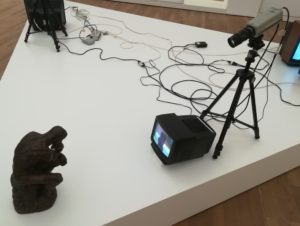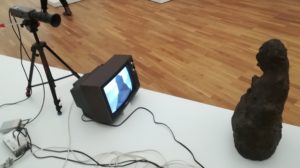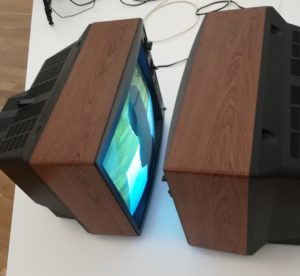Art Moment: Nam June Paik and the rabbit hole of recursion
February 15, 2018 – 12:37 pmNam June Paik (1932 – 2006) was a Korean artist who pretty much kicked off the whole world of video art.
One of his most famous works, which was implemented with variations several times, is the Thinking Buddha. The version I just came across is in the Hamburger Bahnhof in Berlin, and it is more elaborate than most.
A small copy of Rodin’s famous statute The Thinker, maybe 2 foot high, sits opposite a TV screen. A video camera is pointed directly at the thinker, and his image is presented to him on a screen.
Beside this, a statue of the Buddha, coarse and bronze, is likewise positioned in front of a screen on which his image is displayed. The camera relaying the image is obvious and directly over the TV.
Finally, two TVs are arranged at the third corner of the triangular pedestal on which the whole work sits. The screens face each other with no more than about 8 inches separation. On one, the image of the Buddha is shown. On the other, the thinker. The two images face off against each other.
A deep analysis of this work would drop us into the entire weird and wonderful world of self-reference. This is where we find such classic paradoxes as the barber who shaves all those men who do not shave themselves. Does the barber shave himself? This is the heart of Goedel’s incompleteness theorems that place hard limits on the aspirations of any logical system to be both complete and consistent. This is the paradox of recursion at the heart of every system that asserts a self in opposition to a world.



Sorry, comments for this entry are closed at this time.